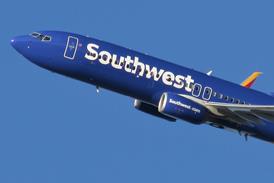Tim Furniss
Japanese space officials at the IHI-Nippon-Mitsubishi stand in Hall 3 say that an aborted test firing of the first stage engine of the National Space Development Agency's new H2A launcher will not delay the maiden flight of the vehicle in February 2001. The static test of the LE-5A cryogenic first stage engine of the H2A was aborted after liquid hydrogen _leaked from a faulty valve in the engine's liquid hydrogen pump which failed to close.
Japan is developing a fleet of four H2A variants offering a payload lifting capability to geostationary transfer orbit (GTO) of 4,000-7,500kg.
Featured
The fifth variant that is featured on the Japanese aerospace stand and includes three first stage core engines is not part of the programme yet, however.
The H2A is Japan's attempt to enter the commercial launcher market seriously, at an attractive cost compared with the $100 million-plus per _launch cost of its predecessor, the H2 booster. This launcher failed on what were destined to become its two final flights last year, plunging the Japanese space programme into the doldrums. The H2A also features an improved LE7B cryogenic upper stage with a 13% increase in thrust. The basic configuration of the vehicle, designated H2A202, is two stages with two new SRB-A solid rocket boosters, offering the same 4,000kg capability as the original H2.CapacityThe H2A2022 adds two small solid boosters to augment the thrust, increasing capability to 4,250kg, while the H2A2024 offers four SRB-As, taking GTO performance to 5,500kg. The H2A212 uses the H2A202 configuration but uses a strap-on, piggyback first stage, providing the maximum 7,500kg to GTO capability. The as-yet-to-be funded H2A222 would use three first stage core boosters.
The first H2A is scheduled to launch the European Space Agency's Artemis satellite while the vehicle fleet, being marketed by the Mitsubishi-led Rocket Systems Corporation, has options to launch 10 Hughes and 20 Loral satellites. Hughes had already cancelled 10 firm bookings after concerns following the failure of the two H2s last year.
Source: Flight Daily News























